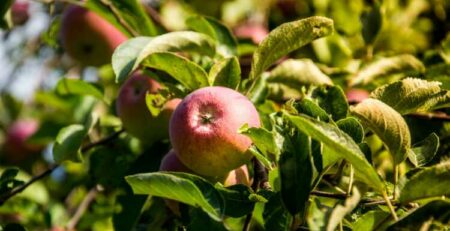How Long Does it Take for a Tree to Grow?
This question comes to most people’s minds when buying a tree to plant on their property. How long does it take to for a tree to fully grow? The question is quite challenging to answer as the word “tree growth” contains different meanings. Trees grow both ways vertically. A tree’s roots will dig deep into the earth to spread their reach while establishing and maintaining a strong base. Above the ground, we see a different picture. We see a tree growing in width and height over the years and sometimes forgot about the underground growth. All trees have different growth rates and growth cycles. Some trees grow their roots all year, while only their trunks and branches may grow in select seasons.
There are a lot of species of trees found throughout the world. According to the latest scientific studies, more than 60 thousand unique tree species are on the planet. The fantastic thing is that every species has a different life span and growth rate. This varying life span leads to a wide variety of different-sized trees dependent upon a variety of factors.
We can’t know the exact life span of a tree. However, we can approximate “how long it takes for a tree to grow” by keeping a few things in mind that affect trees’ growth rate. Below you will find a breakdown of a tree’s growth to better understand how long it takes for a tree to grow.
Seed Germination Stage: 1-3 Weeks
This is the initial step in the growth of a tree. Most often, trees grow from seeds. However, some trees can also grow from the budding process. Tree seeds grow when they have a moist environment and favourable conditions. The seeds have a hard outer shell that breaks when it becomes soft. The moisture from the environment helps soften the shell, and the tree begins to grow. Roots start to sprout, and after that, the first one or two leaves and a small embryo stem emerge from the seed. Over a little while longer, the stem will eventually push itself out of the ground. You will now have a baby tree growing above the ground. This entire process completes within 1 to 3 weeks as long as conditions remain steady and not harmful.

Seedling and Sapling Stage: 6 Months to Several Years
Now that the seedling has formed, we can begin to watch it grow and develop out of the ground. The tree will need maximum protection from environmental factors, including animals, light, temperature, humidity, water, and nutrition. Over time the seedling will continue to grow taller, healthier, and more steady as the roots expand. When it gains enough height, approximately 3 feet, then it is called a sapling. A sapling has a very flexible stem and sometimes small branches. Its bark is usually smooth, but it can’t grow any food. The average amount of time a tree is in the sapling stage will vary depending on the tree. Trees with longer life spans will often have longer sapling times. For example, an Oak-tree will remain a sapling for up to five to six years.
Mature or Fruit Bearing Tree: 4 Years and Onwards
A full-grown tree is one that has grown to over 10 feet in height. Once a tree reaches maturity, it can start producing fruit. This process typically takes 2-10 years for trees with shorter lifespans, and may take longer (up to 20-30 years) for Oak or Pine trees, which tend to have longer life spans. After 80 years, acorn production begins to decrease in some species such as the Oaktree; however, other types of fruit-producing plants, such as berry bushes, start yielding fruit much sooner after being planted.
Ancient Trees: Over 100 Years
Older than most humans and certainly taller. Tree species can take over 100 years to become mature trees. Some of these may even continue to grow after the hundred-year mark. We like to refer to them as “Ancient Trees.” The word ancient seems to encompass a level of vastness and age that is almost incomprehensible. What other living beings do you know that can outlive humans by centuries? Many generations of man come and go, but the trees remain.
In Fishlake National Forest, Utah, USA, there is a clonal colony of trees called Pando. The oldest tree in the world and one of the oldest living organisms, Pando, has an estimated age of 80,000 years. In contrast to most ancient trees, Pando is a clonal colony with a similar underground root system. Although Pando appears to be a forest of individual trees, they are all genetically identical.

Factors that Affect How Long it Takes for a Tree to Grow
Location
Location is one of the most critical factors in determining the growth rate of a tree. Trees in tropical areas have a very long life span and take quite a while to mature. Their growth is not slow, though, as they will gain more height than most other species of tree. They do take more time to become mature and bear fruit. The tropical environment around them supports growth. They will need a lot of water for their growth which tropical climate tends to have more of. If you plant a tropical tree into an environment that is not supported by the environmental conditions, it will slow down its growth and even die. As noted, early sunlight is crucial to tree growth. Sunlight is an essential source for every tree. When trees are subject to more shade than the sun, a decline in the growth will occur versus trees facing the sun directly. Trees facing the sun will almost always have a faster growth rate when compared to those trees that are exposed to the sun less throughout the day.
Species
The type of tree will play significantly into the rate at which a tree will grow. There are species with rapid growth rates that will wither away sooner. At the same time, there are others with slow growth rates that can last for decades. Below you will find a list of different tree species and their approximate life span.
- Redbud – Average of 20 – 30 years.
- Bradford Pear – Average of 20 – 30 years.
- Mexican Plum – Average of 40 years.
- Eve’s Necklace – Average of 50 years.
- Crapemyrtle – Average of 60 years.
- Boxelder – Average of 75 years.
- Cucumbertree – Average of 80 years.
- Cedar Elm – Average of 100+ years.
- Blue Spruce – Average of 150 years.
- Live Oak – Average of 300 years.
- Pecan – Average of 300 years.
- American Elm – Average of 300 years.
- White Oak – Average of 300 years.
- Eastern Hemlock – Average of 450 years.
- White Oak – Average of 600 years.
Climate
Every tree has its season when its growth becomes more and more observable. Often harsh cold conditions will slow down the growth rate of trees. The age of maturity later on in their growth is drastically reduced each winter for trees constantly exposed to this.
The best time to plant new trees is from mid-August to mid-October, but this can be extended into November and December depending on your location. You can tell if the soil temperature is safe for planting by checking it early in the morning for a few days in a row. If the soil temperature is consistently 50° F or higher, then it’s safe to plant new trees.
Trees in mountain areas usually grow in the summer season. For the trees to reach their full growth, it depends on the climate and the water available. In tropical climates with warm weather and a plentiful water supply, a tree can become fully grown in 30 years. A tree in cooler regions may take several hundred years to reach full maturity depending upon the tree species.
Water
Does the tree have a steady supply of water? Is there a seasonal drought that occurs? We all know that water is essential for every living being, and the same goes for trees. Access to water for a tree is essential for an improved growth rate. If a tree has easy access to the water, it will grow faster than a tree that is suffering from scarcity of water. A tree loses about 90% of its water (hundreds of gallons for a large mature tree) to the atmosphere every day. The remaining 10% allows it to function correctly and maintain a healthy, strong life.

Nutrients
A tree can not grow in an environment that lacks the required nutrients necessary for growth. These nutrients are usually inside the ground but sometimes provided by humans and animals. In jungles, tree leaves fall and decay into nutrient materials. Where these nutrients aren’t available, humans may use urea. Urea is an organic and stable fertilizer that can improve the quality of your soil surrounding the tree. When a tree has an abundance of nutrients, it will accelerate the growth rate.
Soil
Soil provides everything that a plant or tree will need for its growth, including the water, nutrients, and moisture for a seed to grow. Good healthy soil allows the roots of a tree to suck up water necessary for tree growth. If a tree is in harsh soil like the mountain ranges, rough terrain, or a snowy area, then it will have a reduced growth rate. If the ground is indeed incompatible with the seed, the seed will not grow at all. Now consider a tree in moist and moderate soil. The tree will grow faster and reach its maturity sooner than the one on the mountains’ side. Dry soil does not help a tree grow. Trees need moist soil to allow for proper root function. If the soil is moist, but there isn’t enough of it, the tree will struggle to grow. Always make sure your tree has a sufficient amount of moist soil.
Tips To Boost Growth Rate
Most of the time, trees have a consistent growth rate. However, we can help them along if they are struggling. Here are a few tips that might help save your tree.
Check your Soil: Check your soil before planting a tree. Is it hard dry soil? Or is it soft and moist? Remember, you want an abundance of soft, moist soil. This will help the seed grow big and strong and for the roots to continue to expand years from now.
Provide Nutrients: Provide your plant with all it needs to grow. For example, urea and other nutrients will help improve the growth rate of the plant. Nutrients are usually provided in terms of fertilizers. You can use coffee grounds as a natural fertilizer to help your plants grow big and strong.
Provide Sunlight: Sunlight is among the most crucial needs of a tree, so always try to plant trees in a place where sunlight is available in the daytime. This may not be easy in some areas. Try to make the most out of it. If you genuinely can’t, ensure that the soil is healthy and provide the tree with additional nutrients.
Protect the Trees from Harm: When the trees are small, they need protection. Trees could be grazed by animals or be harmed or broken by kids or harsh winds. This protection helps the tree to keep growing at the same pace. Keep lawnmowers, electric trimmers and other items that may cause mechanical injury well away from small tree trunks and limbs. Your tree will thank you! Additionally, trimming a tree can help benefit its growth rate.
Provide Water Consistently: It is common knowledge that every living thing needs a water supply to stay alive and grow. It is more crucial for your tree. Establish a watering fertilization schedule that suits the tree’s needs and follow this schedule for better growth.
Examples of Tree Growth
Below you will find a list of different tree species and a bit more about their growth process.

Hybrid Polar Tree
Hybrid poplars are widely used on several soil types and are selected for enhanced cold and drought tolerance, disease, pest resistance, and growth rate. Trees in arid sites will be much smaller and grow much slower than trees in humid areas. Trees can be either males or females; females are the only ones that produce fluffy or cottony seeds.
Shelterbelts made of hybrid poplars are more wind-resistant, better for livestock, and provide food for birds and other animals. Their roots help filter water as they absorb nutrients. Hybrid poplars also help to intercept odour that travels through the air during the growing season, an important property close to concentrated agriculture. This tree’s rapid growth makes it a valuable wood source for use in the production of bio-energy and fibrous materials such as lumber, veneer, pulp and oriented strand board.

Weeping Willow Tree
The tree can also grow between four to seven feet per year, depending on the individual planting it. If properly cared for, it will grow at an even faster rate. It is likely that the weeping willow, which is well-known for its graceful, arching stems that dangle delicately and shiver in a breeze, is the best known among the weeping trees. The deciduous tree leaves are lance-shaped, growing from 3 to 6 inches in length; they turn yellow in the fall and then fall to the ground. A weeping willow has rough, gray bark and long ridges that reach deep to the ground, defining and subduing the trunk. When the willow tree flowers, it produces yellow catkins. Willow trees grow quickly, adding as much as ten feet in their early years. However, willows have a lifespan of only around 30 years on average.

Quaking Aspen Tree
A Quaking Aspen tree is also among the fastest-growing trees. It is a hybrid of the polar family. Its average growth is around 3 to 6 feet per year. We recommend that if you decide to plant a quaking aspen tree for your yard, you should purchase a specimen grown in a nursery rather than have it taken from an out-of-doors site. Trees grown in nurseries require less care, may receive better health, and are less likely to be afflicted by diseases that might otherwise affect them in cultivation. Quaking aspen plant care includes a substantial amount of choosing the right location to achieve successful tree growth. Planting the trees in moist, well-drained soil that is slightly acidic is ideal for their long-term health. Plant aspens on eastern or northern slopes, as well as on the eastern or northern sides of your house, rather than in sunnier areas where droughts or hot, dry conditions may affect them. Learn more about these fantastic trees here.

White Cedar Tree
The White Cedar tree is at the top of the list for the slowest growing trees. These are the smallest conifers (cone-bearing seed plants) found in Canada and Northern America. The eastern white cedar matures to a height of 12 to 15 metres, and it has a trunk diameter ranging between 30 and 60 centimetres, making it a medium-sized tree. The highest trees in the eastern white cedar family can reach 30 meters in height and 80 centimeters in diameter in swampy areas to live for 400 years. What is the growth rate of a Northern white cedar? Mature Height/Breeding: Arborvitae grows up to 40-50 feet in height, offering 15-20 feet in spread. White Cedars grow slowly to medium-slow growth rate, typically 13-24″ per year or more in ideal conditions. Soil/Climate: White Cedar can tolerate limestone soils, boggy areas, and areas that are moist. White cedar trees can flourish in both acidic and alkaline soils. Taking this into consideration, where can one find white cedar trees? Several white cedar trees can be planted together as a natural fence line or screen, especially in locations with partial shade to its full sun. The soil should be sandy, loamy or clay.

Oak Tree
Growing from seeds to mature trees, oaks take between 30 to 40 years to grow, making them a slow and often neglected species in the forest. There are more than 600 species of oaks in the world. Compared with other trees like the Monterrey oak (Quercus polymorpha), white oaks are considered slow-growing trees, rising about 12 to 14 inches in one year, while other species thrive up to 48 inches in one year. Many nurseries are reluctant to stock white oak due to the tree’s slow growth rate, so you may have difficulty finding a specimen to go with your landscape. However, many firms consider white Oak’s beauty and longevity good reasons to invest in a white oak.
So, How Long Does it Take for a Tree to Grow?
From the above discussion, it is clear that we can not exactly tell you how long an individual tree will take. However, we can make our predictions with strong accuracy. This question “how long will it take a tree to fully grow” can be answered indirectly on the basis of known species of the tree, factoring in soil conditions, environmental conditions, the location of the tree and the species of the tree. It is clear that if a tree is provided with what it needs it will grow according to its natural progression.







